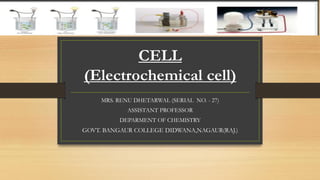Electrochemical cell
•
5 gefällt mir•3,449 views
Galvanic cell and electrolytic cell
Melden
Teilen
Melden
Teilen
Downloaden Sie, um offline zu lesen

Empfohlen
Weitere ähnliche Inhalte
Was ist angesagt?
Was ist angesagt? (20)
Dc,pulse,ac and square wave polarographic techniques new

Dc,pulse,ac and square wave polarographic techniques new
Ähnlich wie Electrochemical cell
Ähnlich wie Electrochemical cell (20)
Electrochemistry class 12 ( a continuation of redox reaction of grade 11)

Electrochemistry class 12 ( a continuation of redox reaction of grade 11)
presentation_electrochemistry_part_i_1651145702_423484.pdf

presentation_electrochemistry_part_i_1651145702_423484.pdf
Kürzlich hochgeladen
Mehran University Newsletter is a Quarterly Publication from Public Relations OfficeMehran University Newsletter Vol-X, Issue-I, 2024

Mehran University Newsletter Vol-X, Issue-I, 2024Mehran University of Engineering & Technology, Jamshoro
https://app.box.com/s/7hlvjxjalkrik7fb082xx3jk7xd7liz3TỔNG ÔN TẬP THI VÀO LỚP 10 MÔN TIẾNG ANH NĂM HỌC 2023 - 2024 CÓ ĐÁP ÁN (NGỮ Â...

TỔNG ÔN TẬP THI VÀO LỚP 10 MÔN TIẾNG ANH NĂM HỌC 2023 - 2024 CÓ ĐÁP ÁN (NGỮ Â...Nguyen Thanh Tu Collection
Kürzlich hochgeladen (20)
General Principles of Intellectual Property: Concepts of Intellectual Proper...

General Principles of Intellectual Property: Concepts of Intellectual Proper...
ICT Role in 21st Century Education & its Challenges.pptx

ICT Role in 21st Century Education & its Challenges.pptx
Exploring_the_Narrative_Style_of_Amitav_Ghoshs_Gun_Island.pptx

Exploring_the_Narrative_Style_of_Amitav_Ghoshs_Gun_Island.pptx
HMCS Vancouver Pre-Deployment Brief - May 2024 (Web Version).pptx

HMCS Vancouver Pre-Deployment Brief - May 2024 (Web Version).pptx
NO1 Top Black Magic Specialist In Lahore Black magic In Pakistan Kala Ilam Ex...

NO1 Top Black Magic Specialist In Lahore Black magic In Pakistan Kala Ilam Ex...
Sensory_Experience_and_Emotional_Resonance_in_Gabriel_Okaras_The_Piano_and_Th...

Sensory_Experience_and_Emotional_Resonance_in_Gabriel_Okaras_The_Piano_and_Th...
On National Teacher Day, meet the 2024-25 Kenan Fellows

On National Teacher Day, meet the 2024-25 Kenan Fellows
Micro-Scholarship, What it is, How can it help me.pdf

Micro-Scholarship, What it is, How can it help me.pdf
TỔNG ÔN TẬP THI VÀO LỚP 10 MÔN TIẾNG ANH NĂM HỌC 2023 - 2024 CÓ ĐÁP ÁN (NGỮ Â...

TỔNG ÔN TẬP THI VÀO LỚP 10 MÔN TIẾNG ANH NĂM HỌC 2023 - 2024 CÓ ĐÁP ÁN (NGỮ Â...
Electrochemical cell
- 1. CELL (Electrochemical cell) MRS. RENU DHETARWAL (SERIAL NO. - 27) ASSISTANT PROFESSOR DEPARMENT OF CHEMISTRY GOVT. BANGAUR COLLEGE DIDWANA,NAGAUR(RAJ.)
- 2. Cell or ❖ What is cell or battery ? A battery is a set of voltaic cells that are connected in parallel.
- 4. An electrochemical cell is a device that can generate electrical energy from the chemical reactions occurring in it, or use the electrical energy supplied to it to facilitate chemical reactions in it. These devices are capable of converting chemical energy into electrical energy, or vice versa. Electrochemical cell Types of cell 2 . Galvanic Or Voltaic Cell ( convert chemical energy into electrical energy) 1 . Electrolytic Cell ( convert electrical energy into chemical energy)
- 5. Galvanic or Voltic Cell – In a Galvanic cell ,electrical energy is produced by a chemical redox reaction. The cell consists of two half-cells connected via a salt bridge or permeable membrane. The electrodes are immersed in electrolytic solutions in each half cell and electrode are connected through an ammeter. .The electrode at which oxidation occurs is called the anode while the electrode at which reduction occurs is called the cathode .
- 6. . Consider ,for instance, a copper rod dipping in a solution of copper sulphate and a zinc rod dipping in a solution of zinc sulphate, as in the Daniel cell. . Both metal rod or electrode are connected through ammeter and the two solutions are connected through salt bridge . . As soon as the circuit complete currents start flowing which is indicated by deflection in the ammeter.
- 7. • The zinc metal passes into the solution as Zn2+ ions liberated two electrons ( Zn(s) → Zn2+ (aq) + 2 e− ) . The process involves oxidation.
- 8. The liberated electrons move into the ammeter and then enter the copper rod. Cu2+Ions extract two electrons each from the copper rod and are discharged as copper metal on the copper electrode Cu2+ (aq) + 2 e− → Cu(s . the process involves reduction.
- 9. ❖ The overall chemical reaction taking place in the galvanic cell , usually called the cell reaction . is thus, Zn + Cu2+ → Zn2+ + Cu ❖ During the reaction, the zinc electrode will be used and the metal will shrink in size, while the copper electrode will become larger due to the deposited Cu that is being produced. A salt bridge is necessary to keep the charge flowing through the cell. Without a salt bridge, the electrons produced at the anode would build up at the cathode and the reaction would stop running.
- 10. Salt bridge
- 12. Voltaic cells are driven by a spontaneous chemical reaction that produces an electric current through an outside circuit. These cells are important because they are the basis for the batteries that fuel modern society. But they are not the only kind of electrochemical cell. The reverse reaction in each case is non-spontaneous and requires electrical energy to occur.
- 13. Electrode Sign : The sign of the anode and cathode in the voltaic or galvanic cells are opposite to those in the electrolytic cells. In galvanic cell , Negative charge development on Zn plate and positive charge development on Cu plate .
- 14. Difference between Galvanic and Electrolytic cell
- 15. ❖Any electrode will behavious like anode or cathode which is based on their electrode potential
- 17. Measurement of Electrode Potential The absolute value of the electrode potential of a single electrode (called single electrode potential) can not be determined because oxidation half cell reaction or reduction half cell reaction cannot takes place. It can only be measured by using some electrode as the reference electrode. The reference electrode used is the standard or normal hydrogen electrode (SHE or NHE).